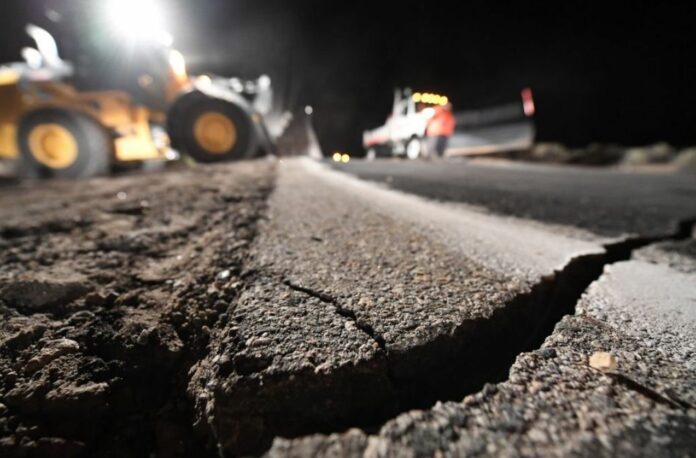On July 4, 2019, an earthquake measuring magnitude 6.4 struck the Searles Valley in California’s Mojave Desert, causing widespread effects throughout Southern California. Approximately 34 hours later, on July 5, the city of Ridgecrest, located nearby, experienced a more powerful magnitude 7.1 earthquake, impacting millions of individuals across California, as well as neighboring regions such as Arizona, Nevada, and Baja California, Mexico.
These seismic events, collectively known as the Ridgecrest earthquakes, were the largest earthquakes California had witnessed in over two decades. The consequences of these earthquakes included significant damage to structures, widespread power outages, and numerous injuries. It was determined that the initial earthquake with a magnitude of 6.4 in Searles Valley served as a foreshock to the subsequent magnitude 7.1 earthquake in Ridgecrest, which was regarded as the mainshock. Following both of these earthquakes, a series of aftershocks ensued.
Scientists were left perplexed by the series of seismic events. The delay of 34 hours between the foreshock and the initiation of the mainshock posed a puzzling question: What caused this considerable time gap? Furthermore, the manner in which these earthquakes transitioned from one segment of the geologic fault system to another raised curiosity. Is there a means of communication between earthquakes, allowing them to interact dynamically?
In order to shed light on these questions, a team of seismologists from Scripps Institution of Oceanography at UC San Diego and Ludwig Maximilian University of Munich (LMU) embarked on a new study focusing on the relationship between the two significant earthquakes, which occurred along a complex multi-fault system. Employing a powerful supercomputer, the team utilized data-driven and physics-based models to establish a connection between the earthquakes.
Leading the study were Scripps Oceanography seismologist Alice Gabriel, who had previously worked at LMU, and her former PhD student at LMU, Taufiq Taufiqurrahman, alongside several co-authors.
Their findings were published today in the journal Nature.
Unraveling the Mysteries of the Ridgecrest Earthquakes
“We used the largest computers that are available and perhaps the most advanced algorithms to try and understand this really puzzling sequence of earthquakes that happened in California in 2019,” explains Gabriel. “High-performance computing has allowed us to understand the driving factors of these large events, which can help inform seismic hazard assessment and preparedness.”
Understanding the dynamics of multi-fault ruptures holds significant importance, as these seismic events tend to be more potent compared to single-fault earthquakes. A prime example of this is the Turkey-Syria earthquake doublet that took place on February 6, 2023, resulting in extensive loss of life and widespread damage. This particular event was characterized by the occurrence of two separate earthquakes within a span of just nine hours, both of which occurred across multiple faults.
During the Ridgecrest earthquakes of 2019, which originated in the Eastern California Shear Zone along a strike-slip fault system, the movement along each fault primarily manifested in a horizontal direction, devoid of any significant vertical motion. The earthquake sequence propagated through intertwined and previously undiscovered “antithetic” faults. These minor or secondary faults exhibit high-angle movements (close to 90 degrees) relative to the primary fault. Within the seismological community, an ongoing debate persists regarding which fault segments experienced active slippage and the factors contributing to the occurrence of cascading earthquakes.
The groundbreaking research introduces a pioneering multi-fault model, which integrates seismograms, tectonic data, field mapping, satellite observations, and other space-based geodetic datasets with the principles of earthquake physics. This represents a significant advancement compared to previous models focused on this specific type of earthquake, as those were solely reliant on empirical data.
“Through the lens of data-infused modeling, enhanced by the capabilities of supercomputing, we unravel the intricacies of multi-fault conjugate earthquakes, shedding light on the physics governing cascading rupture dynamics,” adds Taufiqurrahman.
Researchers at the Leibniz Supercomputing Centre (LRZ) in Germany utilized the powerful supercomputer SuperMUC-NG to investigate the relationship between the Searles Valley and Ridgecrest earthquakes. Through their analysis, they showed a clear connection between these seismic events. They discovered that these earthquakes interacted through a fault system that exhibited static strength but dynamic weakness, owing to intricate fault geometries and low levels of dynamic friction.
Utilizing a 3-D rupture simulation, the research team effectively illustrated how faults, which were initially considered robust prior to an earthquake, can rapidly weaken during the occurrence of a high-speed seismic event. This simulation also provided insights into the dynamics behind the simultaneous rupture of multiple faults.
“When fault systems are rupturing, we see unexpected interactions. For example, earthquake cascades, which can jump from segment to segment, or one earthquake causing the next one to take an unusual path. The earthquake may become much larger than what we would’ve expected,” adds Gabriel. “This is something that is challenging to build into seismic hazard assessments.”
As per the authors, their models possess the capacity to bring about a significant transformation in the field of seismology. They aim to enhance the evaluation of seismic hazards in active multi-fault systems, which are frequently underestimated.
“Our findings suggest that similar kinds of models could incorporate more physics into seismic hazard assessment and preparedness,” adds Gabriel. “With the help of supercomputers and physics, we have unraveled arguably the most detailed data set of a complex earthquake rupture pattern.”
Image Credit: ROBYN BECK/AFP via Getty Images
